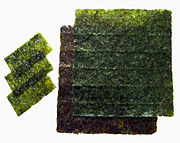Sushi rice
Sushi is made with white, short-grained,Japanese rice mixed with a dressing made of rie vinegar,sugar,salt, and occasionally kombu and sake. It has to be cooled to room temperature before being used for a filling in a sushi or else it will get too sticky while being seasoned. Traditionally, the mixing is done with a hangiri, which is a round, flat-bottom wooden tub or barrel, and a wooden paddle
Sushi rice is prepared with short-grain Japanese rice, which has a consistency that differs from long-grain strains. The essential quality is its stickiness or glutinousness. Rice that is too sticky has a mushy texture; if not sticky enough, it feels dry. Freshly harvested rice (shinmai) typically contains too much water, and requires extra time to drain the rice cooker after washing.
Nori
The black seaweed wrappers used in makimono are called nori. Nori is a type of algae, traditionally cultivated in the harbors of Japan. Originally, algae was scraped from dock pilings, rolled out into thin, edible sheets, and dried in the sun, in a process similar to making rice paper. Whereas in Japan, nori may never be toasted before being used in food, many brands found in the U.S. reach drying temperatures above 42 °C.
The standard size of a whole nori sheet mentioned above influences the size of maki-mono. A full size sheet produces futomaki, and a half produces hosomaki and temaki. To produce gunkan and some other makimono, an appropriately sized piece of nori is cut from a whole sheet.
Nori by itself is an edible snack and is available with salt or flavored with teriyaki sauce. The flavored variety, however, tends to be of lesser quality and is not suitable for sushi.
Toppings and Fillings
Seafoods such as squid, eel, pike conger, octopus, shrimp (ebi and amaebi), clam(mirugai, aoyagi and akagi), fish roe, sea urchin, crab and various kinds of shellfish (abalone, prawn, scallop) are the most popular seafoods in sushi. Oysters, however, are less common, as the taste is not thought to go well with the rice. Kani kama, or imitation crab stick, is commonly substituted for real crab, most notably in California rolls.
Pickled daikon radish in shinko maki, pickled vegetables, fermented soybeans in nattō maki, avocado, cucumber, asparagus, yam, pickled ume, gourd, burdock, and sweet corn may be mixed with mayonnaise.
Tofu and eggs (in the form of slightly sweet, layere omelette and raw quail eggs ride as a gunkan-maki topping) are common.
Condiments
Sushi is commonly eaten with condiments. Sushi may be dipped in shoyu, soy sauce, and may be flavored with wasabi, a piquant paste made from the grated root of the Wasabi Japanica plant.
True wasabi has anti-microbial properties and may reduce the risk of food poisoning.The traditional grating tool for wasabi is a sharkskin grater. An imitation wasabi (seiyo-wasabi), made from horseradish and mustard powder and dyed green is common. It is found at lower-end kaiten zushi restaurants, in benti-box sushi and at most restaurants outside of Japan.
Gari, sweet, pickled ginger is eaten with sushi to both cleanse the palate and aid in digestion. In Japan, green tea is invariably served together with sushi. Better sushi restaurants often use a distinctive premium tea known as mecha. In sushi vocabulary, green tea is known as agari.

No comments:
Post a Comment